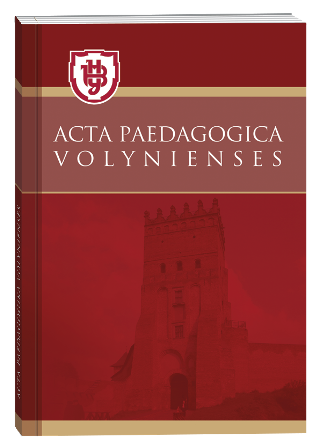«SANDPLAY METHOD» AS A METHOD OF DEVELOPING THE CREATIVITY OF PRESCHOOL CHILDREN
DOI:
https://doi.org/10.32782/apv/2024.4.2Keywords:
creativity, preschool children, preschool education institution, «Sandplay method», principles, enriched play environment, sand games.Abstract
Analyze the study on the essence, content and structure of the creativity of the individual, the prerequisites for its implementation in preschool age, particularly, by «Sandplay method» in the context of new challenges of today. The psychological and pedagogical studies about the essence, content and structure of the creativity of the individual are analysed. The concept of «Sandplay method», which is interpreted as a natural phenomena learning way, a set of interrelated techniques aimed at developing the creativity of preschool children, providing systematic and constant playing activities with sand and water in the process of enriched play environment of preschool education is defined. The essence of the principles on which the method is based: safe and enriched gaming environment, unconditional acceptance of a child, orientation to the individual potential resource of a child, integration into the social environment, humanisation, differentiated approach and integration is revealed. The main advantages of the method, its organisational aspects are considered. Factors that enrich the play environment for children’s activity with sand and maximally contribute to the development of their creative potential are presented (in a group room, on a group playground, in a preschool education institution, at home, on the street). Games, which influence the process of developing children’s creativity are systematised by type: hand-dip in sand games, building games, games using art techniques (relief, collage, assemblage), games for relieving emotional stress. The game themes for each type are given. Conclusions. The definition of creativity of the individual, its content and structure is characterized by great variability. «Sandplay» can be defined as an effective method of influence the development of preschool children creativity, during which process of there is using the technique of working with sand and water; having communication skills, decisionmaking and overcoming difficulties; the ability to combine, reconstruct, changing; creativeness to find decoration options for buildings is; emotional stress is relieved, reducing fatigue and negative emotions, which is especially important in view of today’s challenges during the war and martial law in Ukraine.
References
Архипова С., Кушнірик Н. Методика розвитку творчих здібностей у дітей дошкільного віку. Педагогічні науки. Вип. 2, Полтава, 2009. С.41–48.
Базовий компонент дошкільної освіти в Україні (нова редакція). Т. О. Піроженко, О.М.Байєр, О.К.Безсонова та ін .URL: https://mon.gov.ua/storage/app/media/doshkilna/2020/21.12/bazovyy%20komponent%20doshkillya.pdf
Великий тлумачний словник сучасної української мови : 250000 / уклад. та голов. ред. В. Т. Бусел. Київ; Ірпінь : Перун, 2005. VIII, 1728 с.
Виховуємо базові якості особистості старшого дошкільника в умовах ДНЗ : методичний посібник. За заг. ред. Н. Гавриш. Харків : Мадрид, 2015. 220 с.
Закон України «Про дошкільну освіту». URL : https://zakon.rada.gov.ua/laws/show/3788-20#Text
Каньоса Н. Г. Теорія та технології розвитку дитячої художньої творчості дошкільників: Навч.-метод. посіб. Кам’янець-Подільський : Зволейко Д. Г., 2015. 188 с.
Крутій К. Л., Деснова І. С., Замелюк М. І. Дефініція «гра як провідний тип діяльності дошкільника»: аналіз підходів. Академічні студії. Серія «Педагогіка», Вип. 4, ч. 2, 2021. С.84–91.
Ликова І.О. Образотворча діяльність в дитячому садку. Харків : Ранок. 2008. 215 с.
Лихвар В.Д. Розвиток художньо-творчого потенціалу молодших школярів у процесі образотворчої діяльності: Автореф. дис. ... канд. пед. наук: 13.00.07 / Херсон. держ. ун-т. Херсон, 2003. 24 с.
Моляко В. О. Творчий потенціал людини як психологічна проблема. Психологія і суспільство. №4, 2007. С.6-10.
Образотворче мистецтво з методикою викладання в дошкільному навчальному закладі: Підручник для студентів. За заг. ред. Г.В. Сухорукової. Київ : Видавний Дім «Слово», 2010. 376 с.
Одерій Л. Є., Роздимаха А. І. Образотворче мистецтво як засіб реалізації художньо-творчого потенціалу дітей дошкільного віку. Педагогічні науки: теорія, історія, інноваційні технології, 2014, № 4 (38). С.375–383.
Сисоєва С.О. Соціальні, психологічні та педагогічні підходи до визначення творчої особистості. Педагогічна творчість, майстерність, професіоналізм у системі підготовки освітянських кадрів: здобутки, пошуки, перспективи: монографія. За ред. Н. В. Гузій; Мін-во освіти і науки України, Нац. пед. ун-т імені М. П. Драгоманова. Київ : Вид-во НПУ імені М. П. Драгоманова, 2015. С. 23–56.
Сисоєва С. О., Поясок Т. Б. Психологія та педагогіка: Підручник для студентів вищих навчальних закладів непедагогічного профілю. Київ : Міленіум, 2005. 520 с.
Терещенко О. П. Розвиток творчості старшого дошкільника в образотворчій діяльності: Навч.-метод. посіб. Київ : Світич, 2009. 328 с.
Холоденко В. О. Творчий потенціал особистості: зміст, структура та передумови успішної реалізації у мистецькій освіті. Наукові часописи НПУ імені М. П. Драгоманова. Серія 14. Теорія і методика мистецької освіти. 2019. Вип.26. С.22–28.
Холоденко В. О. Сутність, зміст та структура творчої активності особистості. Наукові записки. Серія «Психолого-педагогічні науки» (Ніжинський державний університет ім. Миколи Гоголя). Ніжин : НДУ ім. М. Гоголя. 2013. № 1. С. 84–88.
Шульга Л. Діяльнісний підхід до формування мистецько-творчої компетентності дитини дошкільного віку. Актуальнi питання гуманiтарних наук : міжвузівський збірник наукових праць молодих вчених Дрогобицького державного педагогічного університету імені Івана Франка. Дрогобич : Видавничий дім «Гельветика», 2021. Вип. 37. Том 3. C. 304–309.
Guilford J.P. Natura inteligencji czlowieka. W.: PWN, 1978. 995p.
Rogers K. R. A Way of Being a Person. Boston : Houghton Mifflin Company, 1980.







